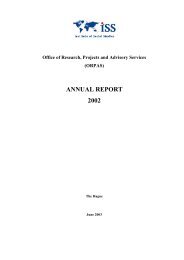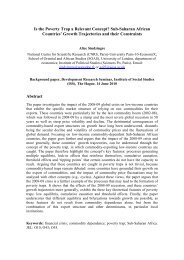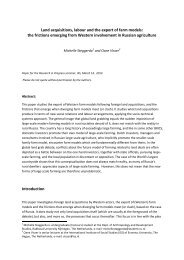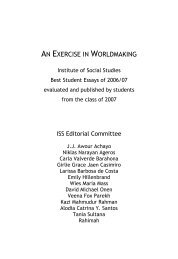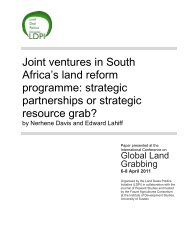AN EXERCISE IN WORLDMAKING 2009 - ISS
AN EXERCISE IN WORLDMAKING 2009 - ISS
AN EXERCISE IN WORLDMAKING 2009 - ISS
Create successful ePaper yourself
Turn your PDF publications into a flip-book with our unique Google optimized e-Paper software.
34 JONATH<strong>AN</strong> CONNOR<br />
for channeling external development efforts toward a more coordinated,<br />
endogenous development agenda. As a result, the indigenous-led municipal<br />
government has begun to shift resources and investment from<br />
the urban center to the canton’s poorer rural communities.<br />
Initiatives such as the Indigenous and Popular Parliament reflect a<br />
growing awareness among Guamote’s indigenous leaders of “the importance<br />
of designing local institutions in accord with local capacities”<br />
(Cameron, 2003: 172). In addition to these types of regulatory and coordinating<br />
mechanisms, the government of Guamote has also made considerable<br />
efforts to include community members, as well as a host of development<br />
actors, in the canton’s development plans. This commitment<br />
to public participation was evident in a series of “development roundtables,”<br />
organized by Guamote’s indigenous leaders. These discussions<br />
provided a forum for both community members and outside agents to<br />
discuss the implementation of various development initiatives in the canton.<br />
During the negotiations, efforts were also made to ensure that<br />
voices in the community were not overshadowed by more formally educated<br />
external actors. These forms of direct participation have been extended<br />
beyond development planning to other governance areas, such as<br />
government auditing and public budgeting (Bebbington, 2007: 59). There<br />
has therefore been a noticeable change in the composition of Guamote’s<br />
local governance structures. Power over local development has shifted<br />
from an exclusive group of white-mestizo landowners to communities and<br />
federations, of which indigenous Quechua citizens are an integral part.<br />
Long excluded from formal and informal criteria of citizenship (Radcliffe<br />
et al., 2002: 290), indigenous and low-income residents are now treated<br />
as local citizens in a much more inclusive and participatory system of<br />
local politics and decision-making. In the following section, I briefly review<br />
the factors underlying Guamote’s transformation before turning to<br />
limitations in the canton’s democratization and development process.<br />
BEH<strong>IN</strong>D GUAMOTE’S SUCCESS, BEYOND ITS REACH<br />
One of the most significant factors supporting the emergence of participatory<br />
municipal institutions in Guamote was a relatively high degree of<br />
indigenous-peasant organization. As noted earlier, social protest was a<br />
driving factor behind Ecuador’s land reform and helped to consolidate<br />
the region’s intercommunity federations. The OSGs, in turn, played a<br />
decisive role in scaling-up collective action, empowering communities




